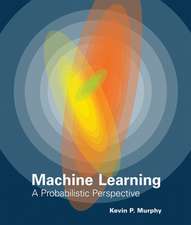Applications of Learning Classifier Systems: Studies in Fuzziness and Soft Computing, cartea 150
Editat de Larry Bullen Limba Engleză Hardback – 16 apr 2004
| Toate formatele și edițiile | Preț | Express |
|---|---|---|
| Paperback (1) | 988.00 lei 6-8 săpt. | |
| Springer Berlin, Heidelberg – 3 aug 2012 | 988.00 lei 6-8 săpt. | |
| Hardback (1) | 994.73 lei 6-8 săpt. | |
| Springer Berlin, Heidelberg – 16 apr 2004 | 994.73 lei 6-8 săpt. |
Din seria Studies in Fuzziness and Soft Computing
- 20%
 Preț: 999.85 lei
Preț: 999.85 lei - 20%
 Preț: 653.06 lei
Preț: 653.06 lei - 20%
 Preț: 872.98 lei
Preț: 872.98 lei - 20%
 Preț: 930.57 lei
Preț: 930.57 lei - 20%
 Preț: 1051.00 lei
Preț: 1051.00 lei - 20%
 Preț: 992.44 lei
Preț: 992.44 lei - 20%
 Preț: 655.85 lei
Preț: 655.85 lei - 20%
 Preț: 1001.86 lei
Preț: 1001.86 lei - 18%
 Preț: 954.14 lei
Preț: 954.14 lei - 20%
 Preț: 330.10 lei
Preț: 330.10 lei - 20%
 Preț: 333.04 lei
Preț: 333.04 lei - 20%
 Preț: 997.56 lei
Preț: 997.56 lei -
 Preț: 391.61 lei
Preț: 391.61 lei - 20%
 Preț: 647.79 lei
Preț: 647.79 lei - 20%
 Preț: 986.01 lei
Preț: 986.01 lei - 18%
 Preț: 958.56 lei
Preț: 958.56 lei - 20%
 Preț: 996.40 lei
Preț: 996.40 lei - 20%
 Preț: 999.35 lei
Preț: 999.35 lei - 15%
 Preț: 646.43 lei
Preț: 646.43 lei - 20%
 Preț: 651.57 lei
Preț: 651.57 lei - 20%
 Preț: 997.89 lei
Preț: 997.89 lei - 15%
 Preț: 641.03 lei
Preț: 641.03 lei - 20%
 Preț: 1009.74 lei
Preț: 1009.74 lei - 20%
 Preț: 992.62 lei
Preț: 992.62 lei -
 Preț: 388.72 lei
Preț: 388.72 lei - 18%
 Preț: 1223.43 lei
Preț: 1223.43 lei - 20%
 Preț: 651.42 lei
Preț: 651.42 lei - 18%
 Preț: 951.59 lei
Preț: 951.59 lei - 18%
 Preț: 948.61 lei
Preț: 948.61 lei
Preț: 994.73 lei
Preț vechi: 1243.41 lei
-20% Nou
Puncte Express: 1492
Preț estimativ în valută:
190.37€ • 198.01$ • 157.16£
190.37€ • 198.01$ • 157.16£
Carte tipărită la comandă
Livrare economică 12-26 aprilie
Preluare comenzi: 021 569.72.76
Specificații
ISBN-13: 9783540211099
ISBN-10: 3540211098
Pagini: 320
Ilustrații: VIII, 305 p.
Dimensiuni: 155 x 235 x 23 mm
Greutate: 0.63 kg
Ediția:2004
Editura: Springer Berlin, Heidelberg
Colecția Springer
Seria Studies in Fuzziness and Soft Computing
Locul publicării:Berlin, Heidelberg, Germany
ISBN-10: 3540211098
Pagini: 320
Ilustrații: VIII, 305 p.
Dimensiuni: 155 x 235 x 23 mm
Greutate: 0.63 kg
Ediția:2004
Editura: Springer Berlin, Heidelberg
Colecția Springer
Seria Studies in Fuzziness and Soft Computing
Locul publicării:Berlin, Heidelberg, Germany
Public țintă
ResearchCuprins
Learning Classifier Systems: A Brief Introduction.- Section 1 — Data Mining.- Data Mining using Learning Classifier Systems.- NXCS Experts for Financial Time Series Forecasting.- Encouraging Compact Rulesets from XCS for Enhanced Data Mining.- Section 2 — Modelling and Optimization.- The Fighter Aircraft LCS: A Real-World, Machine Innovation Application.- Traffic Balance using Learning Classifier Systems in an Agent-based Simulation.- A Multi-Agent Model of the UK Market in Electricity Generation.- Exploring Organizational-Learning Oriented Classifier Systems in Real-World Problems.- Section 3 — Control.- Distributed Routing in Communication Networks using the Temporal Fuzzy Classifier System — a Study on Evolutionary Multi-Agent Control.- The Development of an Industrial Learning Classifier System for Data-Mining in a Steel Hop Strip Mill.- Application of Learning Classifier Systems to the On-Line Reconfiguration of Electric Power Distribution Networks.- Towards Distributed Adaptive Control for Road Traffic Junction Signals using Learning Classifier Systems.- Bibliography of Real-World Classifier Systems Applications.
Textul de pe ultima copertă
This carefully edited book brings together a fascinating selection of applications of Learning Classifier Systems (LCS). The book demonstrates the utility of this machine learning technique in recent real-world applications in such domains as data mining, modeling and optimization, and control. It shows how the LCS technique combines and exploits many Soft Computing approaches into a single coherent framework to produce an improved performance over other approaches.
Caracteristici
Brings together recent real-world applications of a machine learning technique whose performance has been greatly improved in recent years and which is experiencing resurgence in interest Includes supplementary material: sn.pub/extras


















